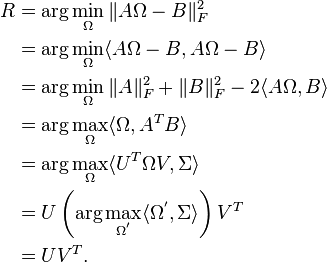Orthogonal Procrustes problem
The orthogonal Procrustes problem [1] is a matrix approximation problem in linear algebra. In its classical form, one is given two matrices  and
and  and asked to find an orthogonal matrix
and asked to find an orthogonal matrix  which most closely maps
which most closely maps  to
to  . [2] Specifically,
. [2] Specifically,
where  denotes the Frobenius norm.
denotes the Frobenius norm.
The name Procrustes refers to a bandit from Greek mythology who made his victims fit his bed by either stretching their limbs or cutting them off.
Solution
This problem was originally solved by Peter Schonemann in a 1964 thesis. The individual solution was later published. [3] A proof is also given in [4]
This problem is equivalent to finding the nearest orthogonal matrix to a given matrix  . To find this orthogonal matrix
. To find this orthogonal matrix  , one uses the singular value decomposition
, one uses the singular value decomposition
to write
Proof
One proof depends on basic properties of the standard matrix inner product that induces the Frobenius norm:
Generalized/constrained Procrustes problems
There are a number of related problems to the classical orthogonal Procrustes problem. One might generalize it by seeking the closest matrix in which the columns are orthogonal, but not necessarily orthonormal. [5]
Alternately, one might constrain it by only allowing rotation matrices (i.e. orthogonal matrices with determinant 1, also known as special orthogonal matrices). In this case, one can write (using the above decomposition  )
)
where  is a modified
is a modified  , with the smallest singular value replaced by
, with the smallest singular value replaced by  (+1 or -1), and the other singular values replaced by 1, so that the determinant of R is guaranteed to be positive. [6] For more information, see the Kabsch algorithm.
(+1 or -1), and the other singular values replaced by 1, so that the determinant of R is guaranteed to be positive. [6] For more information, see the Kabsch algorithm.
See also
References
- ↑ Gower, J.C; Dijksterhuis, G.B. (2004), Procrustes Problems, Oxford University Press
- ↑ Hurley, J.R.; Cattell, R.B. (1962), "Producing direct rotation to test a hypothesized factor structure", Behavioral Science 7 (2): 258–262, doi:10.1002/bs.3830070216
- ↑ Schonemann, P.H. (1966), "A generalized solution of the orthogonal Procrustes problem" (PDF), Psychometrika 31: 1–10, doi:10.1007/BF02289451.
- ↑ Zhang, Z. (1998), "A Flexible New Technique for Camera Calibration", (PDF), MSR-TR-98-71 http://research.microsoft.com/en-us/um/people/zhang/Papers/TR98-71.pdf Missing or empty
|title=(help) - ↑ Everson, R (1997), Orthogonal, but not Orthonormal, Procrustes Problems
- ↑ Eggert, DW; Lorusso, A; Fisher, RB (1997), "Estimating 3-D rigid body transformations: a comparison of four major algorithms", Machine Vision and Applications 9 (5): 272–290, doi:10.1007/s001380050048




